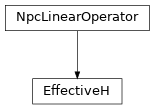EffectiveH
full name: tenpy.algorithms.mps_common.EffectiveH
parent module:
tenpy.algorithms.mps_commontype: class
Inheritance Diagram

Methods
|
|
Return the hermitian conjugate of self |
|
|
Combine the legs of theta, such that it fits to how we combined the legs of self. |
|
Calculate the action of the operator on a vector vec. |
Contract self to a matrix. |
|
|
Equivalent to |
|
Equivalent to |
Class Attributes and Properties
- class tenpy.algorithms.mps_common.EffectiveH(env, i0, combine=False, move_right=True)[source]
Bases:
NpcLinearOperatorPrototype class for local effective Hamiltonians used in sweep algorithms.
As an example, the local effective Hamiltonian for a two-site (DMRG) algorithm looks like:
| .--- ---. | | | | | | LP----H0--H1---RP | | | | | | .--- ---.
where
H0andH1are MPO tensors.- Parameters:
env (
MPOEnvironment) – Environment for contraction<psi|H|psi>.i0 (int) – Index of left-most site it acts on.
combine (bool, optional) – Whether to combine legs into pipes as far as possible. This reduces the overhead of calculating charge combinations in the contractions.
move_right (bool | None, optional) – Whether the sweeping algorithm that calls for an EffectiveH is moving to the right, to the left or not moving.
- dtype
The data type of the involved arrays.
- Type:
np.dtype
- acts_on
Labels of the state on which self acts. NB: class attribute. Overwritten by normal attribute, if combine.
- combine
Whether to combine legs into pipes as far as possible. This reduces the overhead of calculating charge combinations in the contractions.
- Type:
- combine_theta(theta)[source]
Combine the legs of theta, such that it fits to how we combined the legs of self.
- update_LP(env, i, U=None)[source]
Equivalent to
env.get_LP(i, store=True); optimized for combine.- Parameters:
env (
MPOEnvironment) – The same environment as given during class initialization.i (int) – We update the part left of site i. Can optimize if i ==
i0andcombineis True.U (None |
Array) – The tensor on the left-most site self acts on, with combined legs after SVD. Only used if trying to optimize.
- update_RP(env, i, VH=None)[source]
Equivalent to
env.get_RP(i, store=True); optimized for combine.- Parameters:
env (
MPOEnvironment) – The same environment as given during class initialization.i (int) – We update the part right of site i. Can optimize if i ==
i0+ 2 -lengthandcombineis True.U (None |
Array) – The tensor on the right-most site self acts on, with combined legs after SVD. Only used if trying to optimize.
- adjoint()[source]
Return the hermitian conjugate of self
If self is hermitian, subclasses can choose to implement this to define the adjoint operator of self.
- matvec(vec)[source]
Calculate the action of the operator on a vector vec.
Note that we don’t require vec to be one-dimensional. However, for square operators we require that the result of matvec has the same legs (in the same order) as vec such that they can be added. Note that this excludes a non-trivial qtotal for square operators.